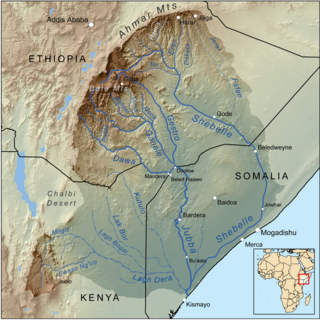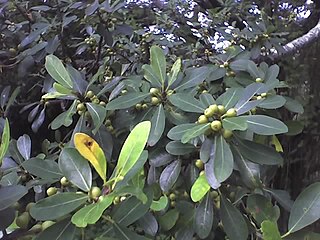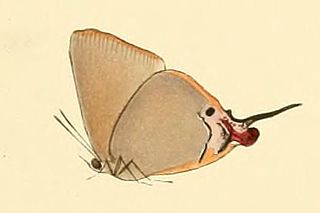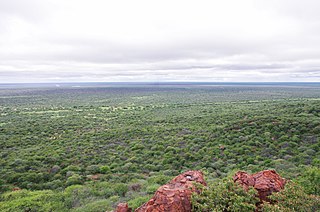
Ficus is a genus of about 850 species of woody trees, shrubs, vines, epiphytes and hemiepiphytes in the family Moraceae. Collectively known as fig trees or figs, they are native throughout the tropics with a few species extending into the semi-warm temperate zone. The common fig (F. carica) is a temperate species native to southwest Asia and the Mediterranean region, which has been widely cultivated from ancient times for its fruit, also referred to as figs. The fruit of most other species are also edible though they are usually of only local economic importance or eaten as bushfood. However, they are extremely important food resources for wildlife. Figs are also of considerable cultural importance throughout the tropics, both as objects of worship and for their many practical uses.

The Kikuyu are a Bantu ethnic group native to East Africa Central Kenya. At a population of 8,148,668 as of 2019, they account for 17.13% of the total population of Kenya, making them Kenya's largest ethnic group.
Mũmbi Muthiga V is regarded as the mother of the Gĩkũyũ people. The word Mũmbi can be translated as the creator, "one who moulds/creates/builds". She and Gĩkũyũ were married, and both are claimed ancestor to all the Agĩkũyũ people. The story of Gĩkũyũ and Mũmbi has been recorded by various writers throughout the Gĩkũyũ orator and history; notable among them are Jomo Kenyatta, the first president of independent Kenya, Louis Leakey and the prolific Gĩkũyũ writer Gakaara wa Wanjaũ and another Gĩkũyũ writer known as Mathew Njoroge Kabetũ among many others. The name Mumbi comes from the Bantu root verb KUMBA, "BA", the same root word that gives rise to "UMBA". The prefix "Mu" is the Bantu noun classifier for nouns that have souls, like humans. The verb UMBA indicates the action of moulding, shaping, designing or creating. The suffix "i" replaces the terminal "a" in the Bantu language noun or verb to create the name for the performer of the action. Being derived from a Bantu root, the word Mumbi is also widely used by the Kamba ethnic community. Among the Kamba community, the name carries the same meaning as among the Kikuyus.
Ngai is the monolithic Supreme God in the spirituality of the Kikuyu and the closely related Embu, Meru and Kamba groups of Kenya, and the Maasai of Kenya and Tanzania. Ngai is the creator of the universe and all in it. Regarded as the omnipotent God, the Kikuyu, Embu, Meru, Kamba and the Maasai of Kenya worshiped Ngai facing the Mt. Kirinyaga while prayers and goat sacrificial rituals were performed under the sacred Mugumo tree. Occasions which may warrant sacrifice or libation include times of drought; epidemics; during planting and harvesting; and human life stages such as birth, marriage and death.

Cordeauxia edulis is a plant in the family Fabaceae and the sole species in the genus Cordeauxia. Known by the common name yeheb bush, it is one of the economically most important wild plants of the Horn of Africa, but it is little known outside of its distribution area. It is a multipurpose plant, which allows the survival of nomads by providing them with seeds. Further, the bush serves forage for livestock, firewood and dye. Its wild population is currently declining. Because it is potentially valuable for other hot, dry regions as a resource for food and fodder, it is recommended to take measures against its extinction.

Ficus sycomorus, called the sycamore fig or the fig-mulberry, sycamore, or sycomore, is a fig species that has been cultivated since ancient times.

The African green pigeon is a species of bird in the family Columbidae, and one of 5 green pigeon species in the Afrotropics. The species has a wide range in Sub-Saharan Africa with around 17 accepted races.

The Dawaro River is found in East Africa, covering an area of, 58,961 km2. It flows through three major countries: Kenya, Ethiopia, and Somalia, with 81% falling into Ethiopian territory. It is known for its complex geological environment, evident through its diverse lithology and structural framework, coming from the river's closeness to multiple volcanic-tectonic events. The wide river has gentle slopes either side of its exposed bedrock. The Dawa river flows south east to form part of the Ethiopia - Somalia border and part of Ethiopia - Kenya border. Awata, Digati, and Mormora are the only significant off-flowing rivers to Dawa.

Ficus natalensis is a tree in the family Moraceae. It is commonly known as the natal fig in South Africa. In central and western Uganda, where it has an important cultural value, it is known as omutuba to the Baganda people and omutoma to the Banyakitara peoples. In English is sometimes referred as barkcloth fig. It is commonly mistaken for its cousin the Ficus thonningii also known as mugumo to the Agikuyu. These trees are distributed from north-eastern South Africa to Uganda and Kenya.

Myrina dermaptera, the lesser fig-tree blue or scarce fig-tree blue, is a butterfly of the family Lycaenidae. It is found in Sub-Saharan Africa, southern Arabia and northern Oman.

Moringa stenopetala, commonly known as the African Moringa or cabbage tree, is a deciduous tree in the plant genus Moringa, native to Kenya and Ethiopia. A drought-resistant species, it is characterized by its bottle-shaped trunk, long twisted seed pods, and edible leaves likened to cabbage, from which its common name is derived. M. stenopetala is extirpated in the wild in Ethiopia, though still grown there as a crop on the terraces of the Ethiopian Highlands, mainly in the Konso region.

Cordia sinensis is a species of flowering tree in the borage family, Boraginaceae. The species’ range extend from South Africa, through East Africa, Madagascar, West Africa and the Middle East to the Indian Subcontinent and Eastern Indochina. There is also a disjunct native population in Senegal. The species has become naturalised in Eastern Australia. Common names include grey-leaved saucer berry, grey-leaved cordia, marer, mnya mate, mkamasi and tadana.

Telfairia pedata, commonly known as oysternut, queen's nut, Zanzibar oilvine, kweme or kulekula, is a dioecious African liana which can grow up to 30 metres long, having purple-pink fringed flowers, and very large, many-seeded, drooping, ellipsoid berries which can weigh up to 15 kg. It is valuable for having edible fruit, seeds and oil.

Ficus sur, with the common names Cape fig and broom cluster fig, is a widespread Afrotropical species of cauliflorous fig.

Combretum apiculatum is a species of tree in the family Combretaceae known by the common name red bushwillow. It is native to the mesic to semi-arid savanna regions of Africa, southwards of the equator.

Ficus vasta is a fig plant found in Ethiopia and Yemen. The tree is a species of sycamore-fig.
Thembinkosi "Nyoso" Lorch is a South African professional soccer player who plays as an attacking midfielder for Orlando Pirates and the South African national team. He was named the South African Player of the Season and Players' Player of the Season in 2019.'

Woody plant encroachment is a natural phenomenon characterised by the increase in density of woody plants, bushes and shrubs, at the expense of the herbaceous layer, grasses and forbs. It predominantly occurs in grasslands, savannas and woodlands and can cause biome shifts from open grasslands and savannas to closed woodlands. The term bush encroachment refers to the expansion of native plants and not the spread of alien invasive species. It is thus defined by plant density, not species. Bush encroachment is often considered an ecological regime shift and can be a symptom of land degradation. The phenomenon is observed across different ecosystems and with different characteristics and intensities globally.

Helichrysum sessilioides is a forb species from Southern Africa.
















